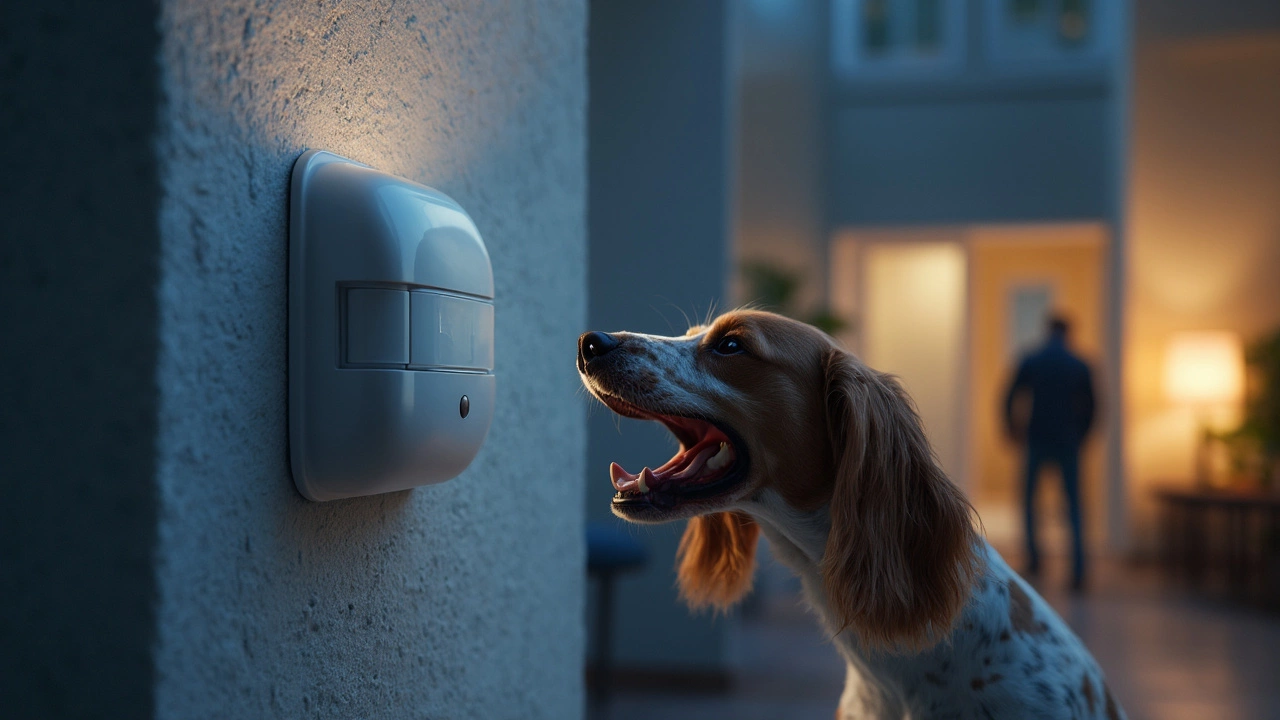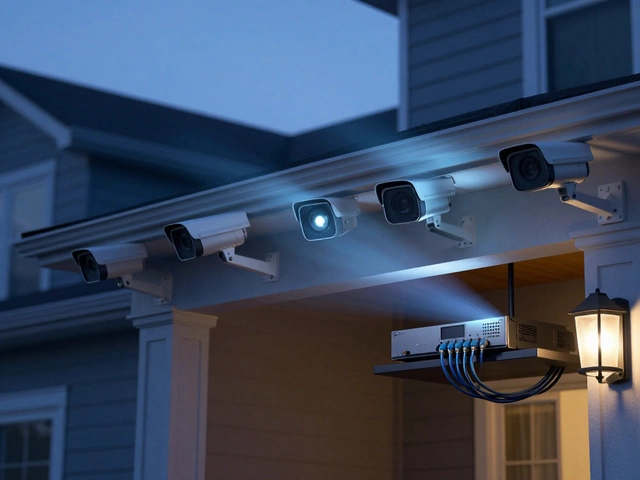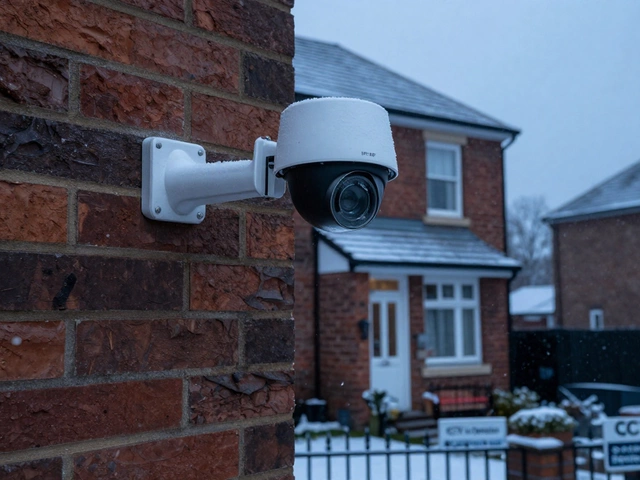Ever raced home because your dog set off the alarm with a couple of loud barks? You're not alone. This headache hits nearly every pet owner at least once. False alarms from barking can waste your time, land you with a fine, and annoy the neighbors.
Most alarms pick up movement, sound, or a break-in attempt—but not all of them know your beagle from a burglar. Some sensors, especially older sound detectors, can't tell a dog's bark from glass breaking or a yell. So, that trigger-happy alarm? It might just be reacting to your pup calling out for delivery drivers or squirrels out the window.
Good news, though: modern pet-friendly alarms are smarter. They use tech that ignores most dog noises and tail-wags, so you get real security without the panic. Picking the right system and quick setup tweaks can mean the end of ‘bark and alarm panic’ for good. Let's cut through the marketing noise and break down why some alarms freak out over barking—and what you can actually do about it.
- Why Pet Noise Triggers Alarms
- Types of Sensors and How They React
- Smart Solutions for Pet Owners
- Real-World Tips to Cut Down False Alarms
Why Pet Noise Triggers Alarms
If your barking dog has ever set off your alarm system, it's mostly down to how alarms listen and react. A lot of traditional alarms use sound sensors or audio detectors. These devices are programmed to listen for specific noises like breaking glass, loud bangs, or yelling—anything that signals trouble. The catch is, a dog bark can hit the same tone, decibel level, or pattern as these targeted sounds, especially when your furry friend has lungs like a siren.
Some alarm systems don’t just rely on sound—they also use motion sensors, especially the basic models. These sensors can trip if your dog runs or jumps near them, but the main culprit for noise-triggered alarms is the microphone. Older alarms are especially bad for this because they aren’t tuned to tell a pet-friendly alarm difference. They throw up a generic alert whenever the sound threshold is passed—bark, bang, or bump.
| Trigger Source | False Alarm Frequency |
|---|---|
| Dog Barking | High with audio sensors |
| Loud TV/Radio | Medium |
| Cats Meowing | Low |
| Person Yelling | High |
One more thing—powerful barks timed just right can fool even glass break detectors that look for sharp vibrations. Security companies have logged reports where larger breeds like German Shepherds or Boxers sent signals identical to breaking glass. That means your loyal protector is actually a pro at setting off false alarms with some solid vocals.
If you have an older alarm or just moved into a place with one, it’s worth checking what kind of sensors you’re running. Newer pet-friendly alarms can filter out everyday pet noise, but legacy systems usually can't. All this boils down to one fact: the tech matters. How your alarm listens decides whether your barking dog means safety or a scramble home.
Types of Sensors and How They React
When it comes to barking dogs and alarms, the nitty-gritty boils down to which kind of sensor your system uses. Not all alarms are built the same, and their "ears" and "eyes" react in surprising ways.
Motion sensors are the most common. Older models aren’t picky—they’ll trip for your dog running through the living room just as fast as for an intruder. Newer pet-friendly alarms use what’s called "pet immunity." Basically, they ignore movement from anything under a set weight (usually 40-80 pounds). If you have a small or medium-sized dog, today’s motion sensors will likely let them walk free without setting off the alarm. Got a big doodle or a very active pup? You might still get a few false alarms, but settings can often be adjusted for size and height.
Sound detectors can be a minefield for pet owners. The old style are sensitive to sudden noises—think barks, dropped pans, or raised voices. These can be especially annoying, since a barking dog often triggers them. More advanced sound sensors now use pattern recognition, looking for the unique high pitch of glass breaking or the low rumble of forced entry, instead of just reacting to volume.
Vibration and shock sensors are less common for whole-home use but you’ll see them on windows or special doors. They don’t care about barking, since they’re looking for shaking or heavy pounding (like someone trying to force a window).
Some modern home security systems even mix sensors, using video analytics to separate normal pet behavior from a possible threat. These can pinpoint if the "movement" is just your golden retriever dashing for his toy, not a person creeping around.
| Sensor Type | Common Trigger | Pet-Friendliness |
|---|---|---|
| Standard Motion | Any movement | Low |
| Pet-Immune Motion | Movement above set weight | High (if pet is under limit) |
| Old Sound Detector | Sudden loud noise | Low |
| Smart Sound Detector | Glass break pattern | Medium-High |
| Vibration Sensor | Physical impact | Very High |
| Video Analytics | Visual recognition | Very High |
So, if your alarm is flipping out every time your dog barks, you're probably dealing with an older alarm system or a sound sensor stuck in the past. Upgrading to a pet-friendly alarm with better sensors pays off—less stress, no random police visits, and your furry friend can bark at will.

Smart Solutions for Pet Owners
If your furry friend's barking keeps setting off your barking dog alarm, you don’t have to just put up with it. Companies are onto this problem, and there are practical fixes that actually work. Here’s the lowdown on how to outsmart false alarms—and keep your home security at full power.
Pet-friendly alarms use motion sensors with “pet immunity.” These sensors are set to ignore movement from pets under certain weights—typically up to 80 pounds for most modern systems. That means a jumping Jack Russell or a snoozing Labrador won’t make your alarm go crazy. Some systems let you program the exact weight limit, so the alarm only reacts to human-size motion.
- Look for alarm models with adjustable sensitivity levels.
- Sound detection systems are getting better at telling the difference between a dog bark and a smashed window using audio pattern recognition.
- Glass break detectors shouldn’t confuse barking with actual breaking glass—pick brands known for this reliability. SimpliSafe and Ring have options that filter out most everyday noises.
- Some new alarm system hubs support two-way audio, so if your dog is stressed and barking, you can talk back through the system and help calm them down before things escalate.
Placement of sensors matters more than you’d expect. Don’t mount motion sensors right where your pup likes to jump on the couch or stare out the front window. A lot of folks find success by gently blocking the lower range of a sensor (with a tall plant or furniture) so it only ‘sees’ human-size activity.
If your system keeps acting up, a technician can usually walk you through custom settings over the phone or in an app. Some monitored alarm companies, like ADT, now let you adjust detection zones and set “pet times” through their apps—meaning extra forgiveness for barking during daylight when you’re at work.
Here’s a quick comparison of some popular systems and their pet-friendliness:
| System | Pet Weight Sensitivity | Special Bark Filtering |
|---|---|---|
| SimpliSafe | Up to 50 lbs | Yes |
| Ring Alarm | Up to 80 lbs | Yes (audio & motion) |
| ADT | Up to 60 lbs | Custom app settings |
If you’ve got multiple dogs or a super-sized breed, mention it when you shop—this matters for the kind of detectors you’ll need. Swapping out old detectors for pet-friendly versions isn’t usually hard, but read reviews before you buy—some “pet immune” sensors still get tripped by a big bark or a climbing cat.
Real-World Tips to Cut Down False Alarms
Cutting down on false alarms doesn’t have to be complicated. Here’s what works in real homes with real dogs. The first step? Make sure your alarm system is truly pet-friendly—not just “pet-tolerant.” A lot of folks don’t realize how much setup matters, not just the brand you pick.
Placement is a game-changer. Avoid putting motion sensors at tail-wag height or right where your pets hang out most. If you leave your dog in a specific room while you’re gone, shut the door, or better yet, use sensors angled above the height of your dog. A lot of newer sensors allow you to adjust the sensitivity or even set a “pet weight” limit. For example, several popular models ignore motion from animals under 40 pounds.
Sound detectors aren’t always the villain, but if you have one, check if it has adjustable sensitivity. Turn it down till your dog’s barks don’t register, but sudden sharp noises (like glass breaking) still do. There’s nothing worse than a truck rumbling by and your barking dog setting off the whole street!
“Most calls about false alarms come from homes with pets who were left out or sensors placed too low. Small changes make a huge difference.” — Tyler Grange, Security Tech for HomeGuard Solutions
If your alarm lets you zone areas, create pet-only zones where sensors either stay off or run at lower sensitivity. Wired systems almost always allow this, but even many wireless systems now offer customizable zones via their apps. If you’re still getting alerts, try swapping sound sensors for glass-break or infrared motion detectors—the latter aren’t activated by sound, so barking won’t matter.
- Keep your alarm system firmware and mobile app updated—manufacturers fix bugs related to pet movement all the time.
- Test your system regularly by arming it and having your dog move/bark while you watch each sensor’s response.
- Record the most common triggers for your false alarms so you can tweak sensor settings or swap them out if needed.
- Tell your alarm service you have pets, so they add a warning to your account—dispatch will often call for confirmation before sending help when you mention animals are home.
Here’s a quick look at how sensitivity settings make a difference:
| Sensor Setting | Most Common Outcome |
|---|---|
| High Sensitivity | Dog barks or moves, alarm triggers easily |
| Medium Sensitivity | Barking ignored, but running/jumping might still trigger |
| Low Sensitivity | Ignores most pet activity, best if you want zero pet alarms |
You can kick false alarms for good with some smart adjustments and honest testing. Your neighbors (and your sanity) will thank you.






